Affiliate marketing is an advertising strategy that pays commissions to third-party individuals (affiliates or influencers) to promote a brand’s product and services. It existed long before the Internet age but gained popularity due to the boom of digital marketing.
In affiliate marketing, companies pay commissions for every lead (or click) the affiliate generates or for every actual sale transaction. The typical affiliate commission is around 10-20%, but some affiliate programs can pay as low as 3%-5% while some programs pay as high as 70%. Commissions vary depending on the industry and products involved.
Amazon popularized modern affiliate marketing with its Amazon Associates Program. The program has almost a million affiliates promoting links to various Amazon products or services using different channels like blogs, banner ads, and social media. Affiliate marketing accounts for 45% of Amazon’s annual revenues.
In 2021, affiliate marketing accounted for 16% of e-commerce’s global sales revenue. You can argue that affiliate marketing is one of the best advertising methods for e-commerce brands.
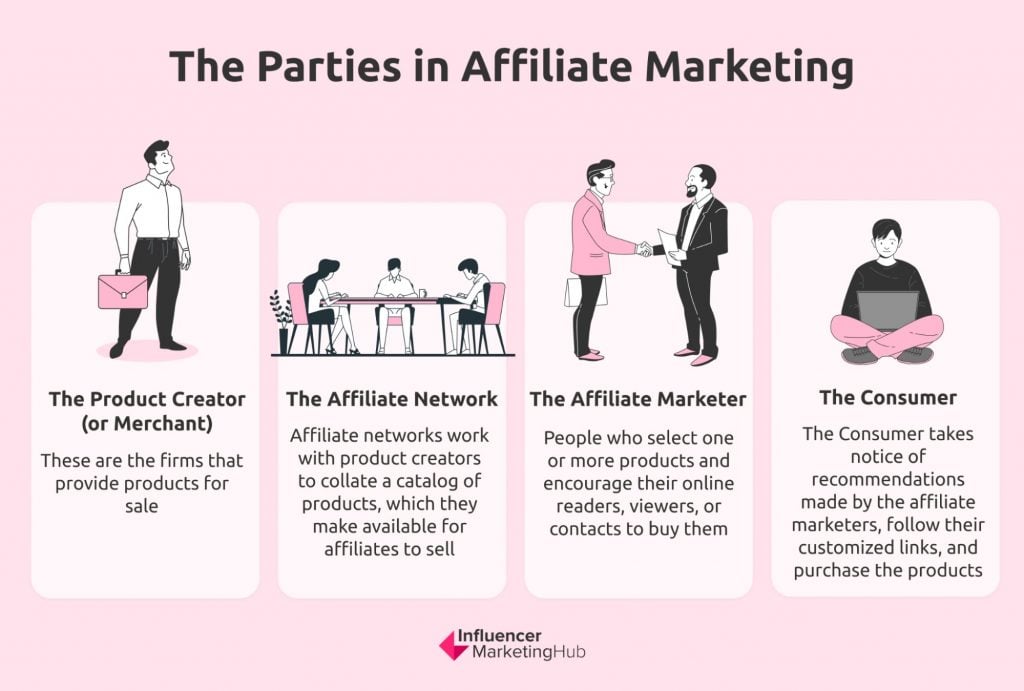

There are four (4) major parties involved in affiliate marketing:
- The brand or company which sells the product
- The affiliate marketer or influencer who promotes the product
- The affiliate network or platform that tracks the sales produced by the affiliates
- The customer who purchases the product
In this article, we’ll discuss how a brand or company can take advantage of affiliate marketing by finding the right affiliates, using the right affiliate networks, and reaching the right target customers.
Affiliate marketing programs can be done using any digital channel. However, this article will focus on affiliate marketing programs through Instagram. It will discuss:
- why Instagram is the best channel to run an affiliate marketing program
- how to successfully run affiliate marketing on Instagram
- examples of brands who are doing it right
But before we go there, it’s important to understand the three (3) types of affiliate marketing programs.
Ultimate Guide to Building an Affiliate Marketing Program on Instagram:
3 Types of Affiliate Marketing Programs
Before you begin strategizing for an affiliate marketing program, you need to know what kind is suited to your brand. Here are three basic types you should consider:
- Unattached
- Relative
- Involved
Unattached affiliate marketing involves affiliates who don’t necessarily use the product being promoted. The affiliates don’t have to be experts in the product’s niches or influencers with a dedicated following. A good example is the Amazon Affiliates Program. Anyone who meets the basic requirements can become an affiliate. They don’t need to be brand experts in order to start being an affiliate. Of course, it’s a different story if they want to become successful affiliates.
Affiliate marketing works best when the affiliates promote the product based on their industry authority or personal experience in using it. This leads us to the 2nd and 3rd types of affiliate marketing programs.
Relative affiliate marketing involves an affiliate who is an industry or niche expert and can vouch authoritatively for the product. They can use their influence to promote the brand, but they don’t necessarily claim to have personal experience in using any of its products. This is powerful enough because consumers trust the expertise and authority of the influencer. However, it is not as powerful as the third type.
Involved affiliate marketing is when the affiliate personally uses the product they’re promoting. In the age of social media, social proof is the biggest motivator for consumers to purchase a product. When an influencer narrates how they’ve personally experienced a product’s benefits, consumers are more likely to believe it and purchase the item.
However, this comes with certain risks and limitations. Influencers can lose credibility or damage their reputation if consumers have a different and negative experience. Depending on your product, this can also be limiting since influencers who have no use for your product are automatically eliminated from being an affiliate.
Despite the risks of involved affiliate marketing, this is still the most effective type since brand credibility is built through genuine social proof. With this kind of affiliate program, you are also guaranteed to reach your target consumer base.
Advantages and Disadvantages of Affiliate Marketing Programs
Now that you know the types of affiliate marketing programs, let’s discuss the benefits and risks of running one.
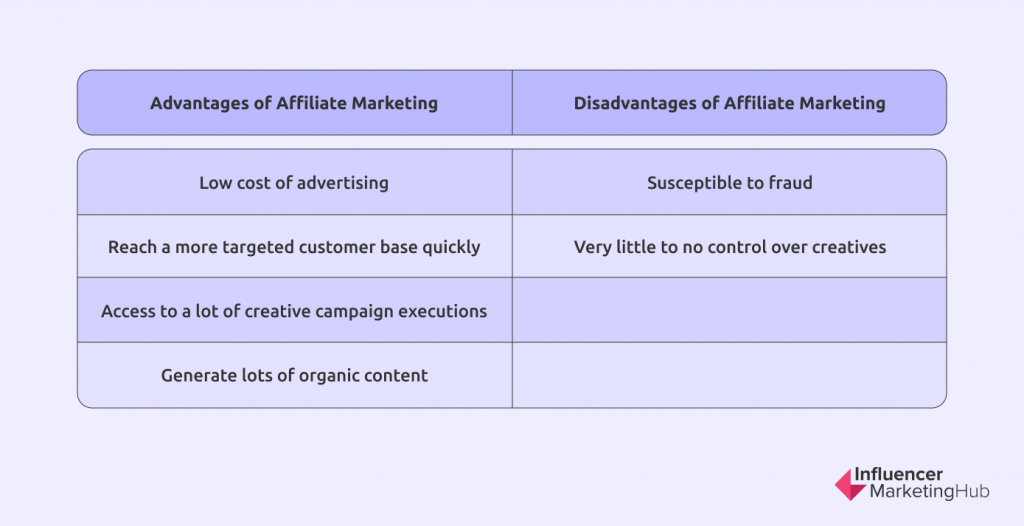

Advantages
Affiliate marketing programs have the lowest cost of advertising among various advertising models. If you choose to pay only when a sale is consummated, then you run almost zero risk of spending huge amounts on advertising without any sales results.
Affiliates are in charge of running creative advertising promotions from social media contests to paying for digital ads in order to promote their own unique affiliate links.
With affiliate marketing, your brand also gains immediate and massive exposure to an influencer’s audience. This creates a quick and efficient means to expand your customer base without your company spending thousands to find them. Just engage with influencers who are part of your target market, and you’re guaranteed to tap the same market through their existing fan base.
Finally, affiliate marketing, when done correctly, produces the highest brand trust among all types of advertising. With this method, you incentivize actual customers to act as salespeople of your brand. By talking about their personal experience in using your products, they build credibility for your company. They also produce user-generated content that can be part of your organic marketing campaigns. Recent studies show that 90% of consumers are influenced by user-generated content when making a purchase.
Disadvantages
Affiliate marketing also has its drawbacks. It is susceptible to fraud when not set up correctly. There have been instances when affiliates would manipulate clicks in order to gain more traffic to their affiliate links. Incentivizing only for actual sales, and not for clicks, is a way to deter this.
In affiliate marketing, you don’t control how affiliates market your brand. They are free to design their own creatives and run their own campaigns to promote your product. For some brands, this can be a nightmare, especially if you have a specific brand image to uphold. To prevent this, you can include brand guidelines and rules as part of your affiliate requirements. You can also have a more stringent screening process for your affiliates. By selecting influencers who match your brand persona, you can be confident that your branding will remain intact in their promotions.
Lastly, when running an affiliate marketing program, watch out for product returns. If you notice a lot of them, it’s possible that your affiliates are misrepresenting the product and giving out misleading claims. This could eventually damage your brand. Learn how to spot these early and suspend affiliates who trick customers into purchasing your products.
The advantages of affiliate marketing far outweigh the disadvantages. As long as you set up the program properly, you can mitigate the risks and have a profitable and efficient affiliate marketing program.
Why Instagram?
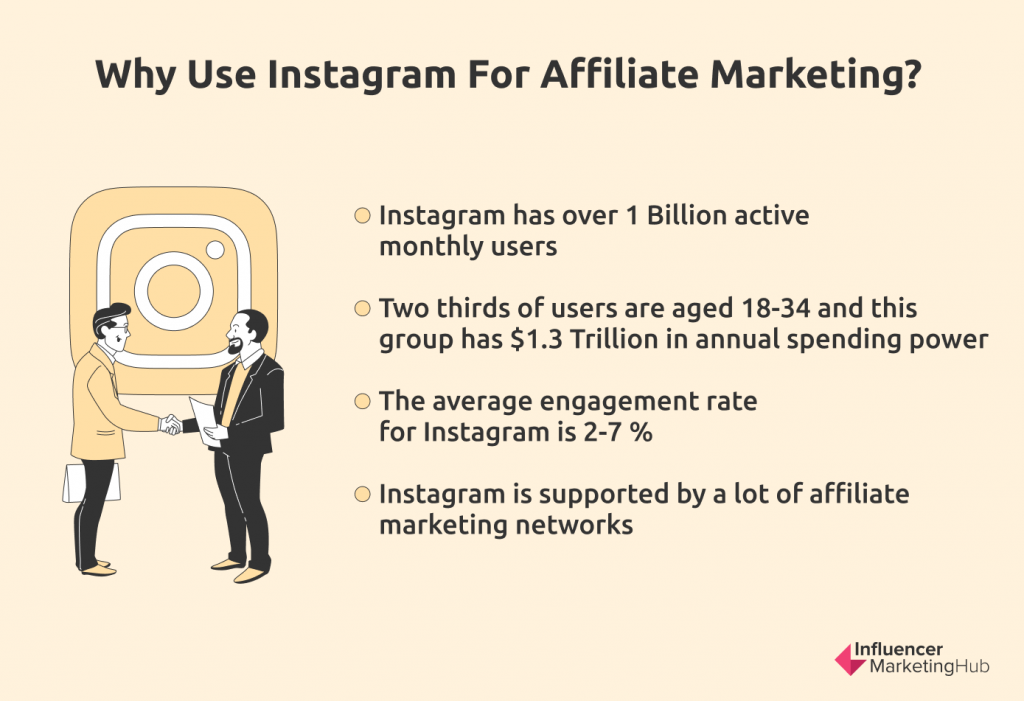

Instagram is one of the world’s largest social media networks with more than 1 billion active users. It’s a visual platform where over two thirds of users are aged 18 to 34. This age group is known to have $1.3 trillion annual buying power.
Influencers are also huge fans of Instagram because there are a lot of places where they can place their affiliate links. There are IG stories, IG post captions, IG TV captions, IG Reels, and the IG bio description. Instagram has made it easy and convenient to advertise affiliate links without making them look tacky or spammy. Everything feels natural and organic, which influencers value and consumers trust.
This makes engagement rates on Instagram higher than other social media platforms. The average engagement rate for Instagram is at 2%-7%. As a whole, Instagram doesn’t appear to be very intrusive with its ads. Promotion on Instagram is natural and mimics how advertising in offline social interactions happens.
To top it off, Instagram is supported by a lot of affiliate marketing networks, making it easy for brands and influencers to track their affiliate links.
Setting Up Affiliate Marketing on Instagram
Creating an affiliate marketing program is relatively easy. Basically, you recruit affiliates, give them a unique affiliate link, get them to promote that link, and pay these affiliates a commission for every sale the link generates.
But running a successful affiliate marketing program involves careful planning and constant data analysis to ensure everything runs smoothly.
Step 1: Know your goals and your competition
When creating goals for your affiliate program, you need to answer the following questions:
- What kind of audience do you want to reach?
- What type of affiliates will help you get there?
- What is your monthly revenue goal brought by your affiliates?
- What’s the average order value driven by affiliates?
- How many impressions and clicks do you want your affiliate links to have?
You should also understand that not all products work well with an affiliate marketing setup. Affiliate marketing is best for products that command high customer retention rates. This makes the commission you paid to acquire that customer worth it. Brands in the following industries thrive with affiliate marketing: e-commerce, beauty, apparel, tech, health, and subscription services.
It is also helpful to analyze your competition’s affiliate programs. These can be direct or indirect competitors who target the same audience.
Here are things you should check out:
- How much commission do they pay their affiliates?
- What triggers the commission? Is it per click or per sale?
- Do they pay affiliates in cash or store credits?
- What’s the affiliate recruitment process?
- Are there affiliate training programs?
- What are the terms and conditions?
Affiliate marketing programs are a dime a dozen. By performing the steps above, you create a program that will appeal to your customers and increase your chances of success.
Step 2: Set your commission rates
Now that you know how much commission your competitors pay, it’s time to decide your own commission rates and how you’ll pay them. You want to be competitive but also sustainable. Don’t give out commissions that will hurt your company’s bottom line in the long run.
When deciding the right commission structure, you should ask the following questions:
- How much does it cost to gain one customer? (Customer Acquisition Cost)
- How many customers do you retain in a year? (Customer Retention Rate)
- How much revenue will one customer bring? (Customer Lifetime Value)
Knowing these factors will help you decide how much commission to pay your affiliates. Remember that it’s better to pay your affiliates for every actual sale transaction. Don’t pay per clicks or impressions!
You should also decide if you want to pay a fixed amount for every sale or a percentage of the total sale value. Are you going to pay in cash or store credits? The most attractive affiliate programs pay percentage commissions in cash.
Another way you can create a competitive commission structure is to offer commission bonuses if affiliates reach a certain revenue target. These bonuses will motivate affiliates to drive up revenues for added compensation.
Step 3: Find your first affiliates and start building your affiliate network
Now that everything is ready, it’s time to find your first affiliates. There are two ways to do this. You can sign up with an existing affiliate network or you can create your own. Whatever path you choose, you need to set up an account in an affiliate tracking platform, so you can monitor your affiliates’ performance.
Option 1: Existing Affiliate Marketing Network
If you’re just starting out, joining an existing affiliate marketing network is probably the easiest and fastest route. They already have relationships with the top performing affiliates in your niche and can help you find other affiliates. They also have the tools and platform you’d need to track your affiliates.
These networks also help you determine the best commission rate and payout scheme in order to be competitive.
Some of the well-known affiliate networks are:
However, affiliate networks also charge a huge commission (like a finder’s fee) on top of the commission you pay an affiliate. This can sometimes be as high as 30% of the commission you pay. For example, if you paid $100,000 in affiliate commissions, the network will charge $30,000 in fees.
Option 2: Your Own Personal Affiliate Network
If you’re not keen on relying on an existing affiliate network, you can always find your own affiliates. To do this, you need to come up with a list of reputable websites, bloggers, and social media influencers who are popular in your niche or that your potential customers already follow. These are the people your future customers already trust and respect. They have already built their own personal audience by producing quality content and becoming a subject matter expert.
You can always approach the people behind these successful accounts and invite them to become affiliates. It’s a bonus if they already use and love your product.
Another way is to have an open application for affiliates on your website. Promote your affiliate program, so affiliates will find you and apply. Carefully screen these applications to make sure they fit your niche, resonate with your brand, and have a reputable channel. You don’t want to end up having fraudulent affiliates because this can hurt your brand.
Look for Instagram Influencers
Since you’re targeting influencers on Instagram, you can use hashtags and search the platform for users who are talking about things related to your brand. You can also check their accounts’ followers and determine which accounts have engaged and active followers. You can always reach out to them and invite them to your affiliate program.
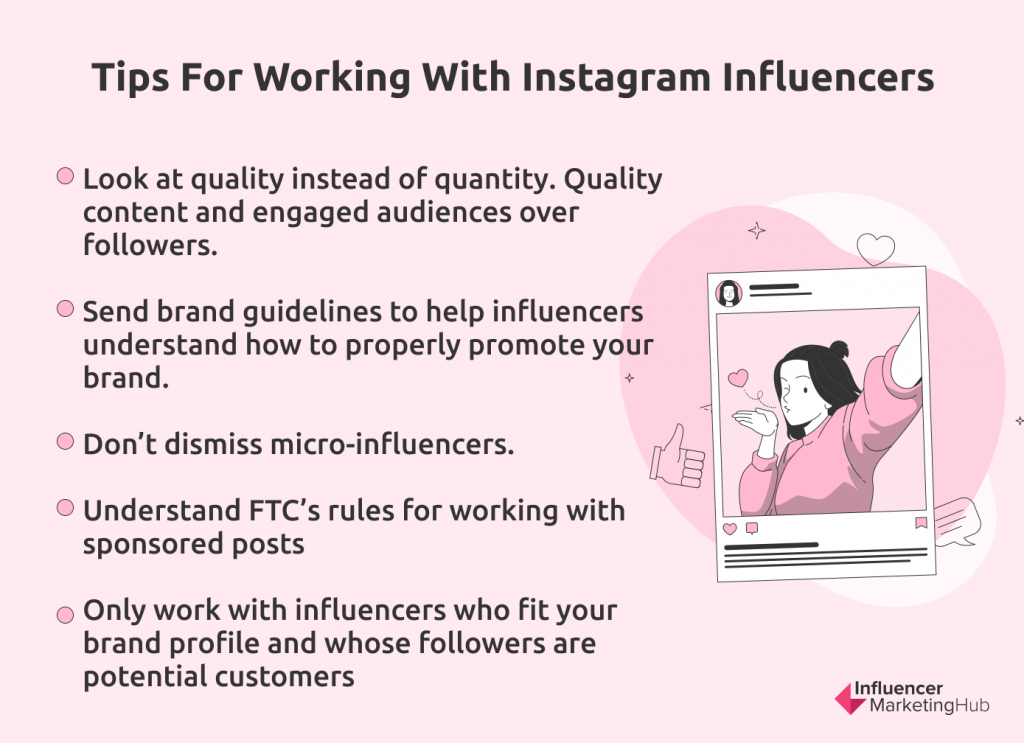

Tips for Working With Instagram Influencers
- Look at quality instead of quantity. Go for influencers who post quality content and have an engaged audience instead of just having a lot of followers.
- Send brand guidelines to help influencers understand how to properly promote your brand.
- Don’t dismiss micro-influencers.
- Understand FTC’s rules for working with sponsored posts
- Only work with influencers who fit your brand profile and whose followers are potential customers
Step 4: Track and analyze your affiliate marketing data
Always track how well your affiliate program is doing. Check if it’s meeting the goals you determined in Step 1 and be prepared to pivot if needed.
If you’re working with an existing affiliate network, they will have available data reports to tell you how well your program is doing. If you’re building your own affiliate network, you need to sign up with an affiliate marketing platform that can track the data for you.
Measure how well your metrics are being met and analyze if there’s a need to adjust your commission rates. Evaluate if the program is attractive and sustainable for affiliates and be wary of inactive affiliates. This could be an early indicator that the program is not competitive enough.
But don’t just focus on affiliate marketing metrics. Evaluate these metrics in conjunction with other business metrics like profitability and product returns. If you find that the affiliate program is not profitable, don’t be afraid to adjust or revamp it completely.
Brands With Highly Effective Affiliate Programs
These brands have successfully developed their affiliate marketing programs on Instagram and have proven that the platform is an effective affiliate channel.
- Successful Instagram Affiliate Program 1: Mejuri
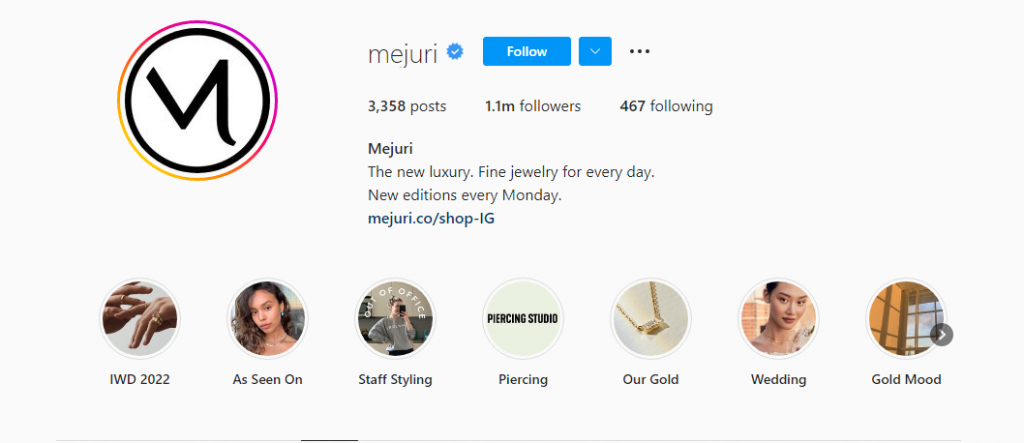

Mejuri is a jewelry company that has built an extensive network of sophisticated female influencers as affiliates. It has micro-influencers and macro-influencers who regularly share stunning photos with its products. This leads to a lot of user-generated content that the company can repurpose for its own use.


Cosmetics brands like The Crème Shop can benefit a lot from running affiliate marketing programs. This brand has a lot of user-generated content including creative video tutorials from its user base with users who are incentivized to keep using and promoting its products. Affiliates are powerful product promoters because they can show customers creative ways to use your products.
- Successful Instagram Affiliate Program 3: Spicentice


Spicentice knows that people love sharing photos of food on social media. By showing what’s possible with Spicentice’s product range, affiliates can convince their followers to try the product for themselves. The use of unique discount codes further encourages followers to make the purchase.
Wrapping Up
Affiliate marketing is a great way for brands and influencers to work together in a win-win situation. Brands benefit with increased credibility, creative user-generated content, and a wider audience base. Influencers, on the other hand, are assured of a steady income simply by sharing how they are using the brand’s products.
49% of consumers rely on influencers’ recommendations prior to making a purchase. Instagram is a strong and stable platform for influencers to reach their audience and for brands to have a visual showcase of their products.
With careful planning, defined guidelines, and consistent monitoring, companies can successfully execute affiliate marketing programs on Instagram and many other channels.
Frequently Asked Questions
How do I start with affiliate marketing on Instagram?
As a brand, you should set up an affiliate program as you would with other channels. Create your affiliate marketing goals, define your program guidelines, and start building your affiliate network. You can begin scouting influencers on Instagram by using hashtag search, going through your followers’ profiles, and monitoring brand mentions.
How many Instagram followers does an influencer need to be a successful affiliate?
There is no defined number of followers required to become a successful affiliate marketer on Instagram. With the rise of micro-influencers, even accounts with less than 2,000 followers can become great affiliates. However, a good number is 5,000 to 15,000 followers to expect a substantial sale from affiliate marketing. At the end of the day, look for high engagement rate vs. the number of followers.
Where can affiliates post affiliate links on Instagram?
Affiliate links can appear anywhere on Instagram that allows links. You can place links on IG stories, post captions, IGTV descriptions, and link in bio. In case of multiple links, influencers use a linking service like Linktree to showcase all their affiliate links in their bio.
Should influencers advertise the use of promo codes or affiliate links?
Both are valid ways to get clicks and sales. Affiliate links are unique trackable links used to measure a sale from an affiliate. In case customers decide to go to the website directly, using an influencer’s unique promo code allows the brands to trace that sale back to the influencer.
How much do influencers earn from affiliate marketing?
Influencers have various ways to earn on Instagram. They can earn from affiliate links, merchandise sale, and monetization tools. While there is no defined data on how much influencers earn from affiliate marketing alone, a Business Insider article reported that one influencer who was interviewed disclosed making $5,000 per month in 2020 via affiliate links alone.


